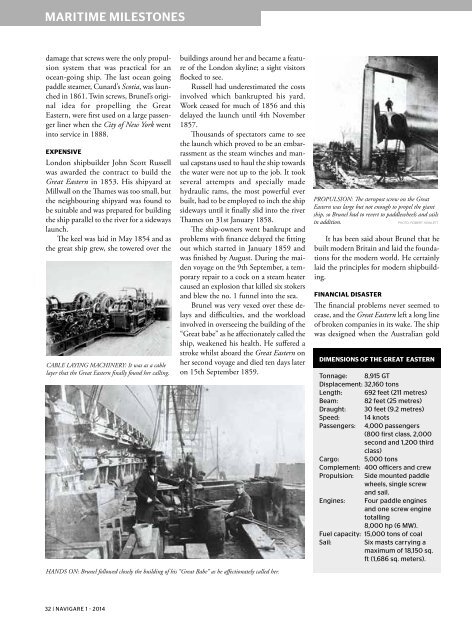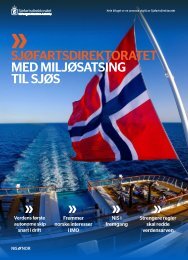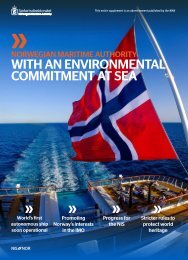You also want an ePaper? Increase the reach of your titles
YUMPU automatically turns print PDFs into web optimized ePapers that Google loves.
maritime milestones<br />
damage that screws were the only propulsion<br />
system that was practical for an<br />
ocean-going ship. The last ocean going<br />
paddle steamer, Cunard’s Scotia, was launched<br />
in 1861. Twin screws, Brunel’s original<br />
idea for propelling the Great<br />
Eastern, were first used on a large passenger<br />
liner when the City of New York went<br />
into service in 1888.<br />
EXPENSIVE<br />
London shipbuilder John Scott Russell<br />
was awarded the contract to build the<br />
Great Eastern in 1853. His shipyard at<br />
Millwall on the Thames was too small, but<br />
the neighbouring shipyard was found to<br />
be suitable and was prepared for building<br />
the ship parallel to the river for a sideways<br />
launch.<br />
The keel was laid in May 1854 and as<br />
the great ship grew, she towered over the<br />
CABLE LAYING MACHINERY: It was as a cable<br />
layer that the Great Eastern finally found her calling.<br />
buildings around her and became a feature<br />
of the London skyline; a sight visitors<br />
flocked to see.<br />
Russell had underestimated the costs<br />
involved which bankrupted his yard.<br />
Work ceased for much of 1856 and this<br />
delayed the launch until 4th November<br />
1857.<br />
Thousands of spectators came to see<br />
the launch which proved to be an embarrassment<br />
as the steam winches and manual<br />
capstans used to haul the ship towards<br />
the water were not up to the job. It took<br />
several attempts and specially made<br />
hydraulic rams, the most powerful ever<br />
built, had to be employed to inch the ship<br />
sideways until it finally slid into the river<br />
Thames on 31st January 1858.<br />
The ship-owners went bankrupt and<br />
problems with finance delayed the fitting<br />
out which started in January 1859 and<br />
was finished by August. During the maiden<br />
voyage on the 9th September, a temporary<br />
repair to a cock on a steam heater<br />
caused an explosion that killed six stokers<br />
and blew the no. 1 funnel into the sea.<br />
Brunel was very vexed over these delays<br />
and difficulties, and the workload<br />
involved in overseeing the building of the<br />
“Great babe” as he affectionately called the<br />
ship, weakened his health. He suffered a<br />
stroke whilst aboard the Great Eastern on<br />
her second voyage and died ten days later<br />
on 15th September 1859.<br />
HANDS ON: Brunel followed closely the building of his “Great Babe” as he affectionately called her.<br />
PROPULSION: The sternpost screw on the Great<br />
Eastern was large but not enough to propel the giant<br />
ship, so Brunel had to revert to paddlewheels and sails<br />
in addition.<br />
Photo: Robert Howlett<br />
It has been said about Brunel that he<br />
built modern Britain and laid the foundations<br />
for the modern world. He certainly<br />
laid the principles for modern shipbuilding.<br />
FINANCIAL DISASTER<br />
The financial problems never seemed to<br />
cease, and the Great Eastern left a long line<br />
of broken companies in its wake. The ship<br />
was designed when the Australian gold<br />
Dimensions of the Great Eastern<br />
Tonnage: 8,915 GT<br />
Displacement: 32,160 tons<br />
Length: 692 feet (211 metres)<br />
Beam: 82 feet (25 metres)<br />
Draught: 30 feet (9.2 metres)<br />
Speed: 14 knots<br />
Passengers: 4,000 passengers<br />
(800 first class, 2,000<br />
second and 1,200 third<br />
class)<br />
Cargo: 5,000 tons<br />
Complement: 400 officers and crew<br />
Propulsion: Side mounted paddle<br />
wheels, single screw<br />
and sail.<br />
Engines: Four paddle engines<br />
and one screw engine<br />
totalling<br />
8,000 hp (6 MW).<br />
Fuel capacity: 15,000 tons of coal<br />
Sail:<br />
Six masts carrying a<br />
maximum of 18,150 sq.<br />
ft (1,686 sq. meters).<br />
32 | <strong>Navigare</strong> 1 - <strong>2014</strong>


















